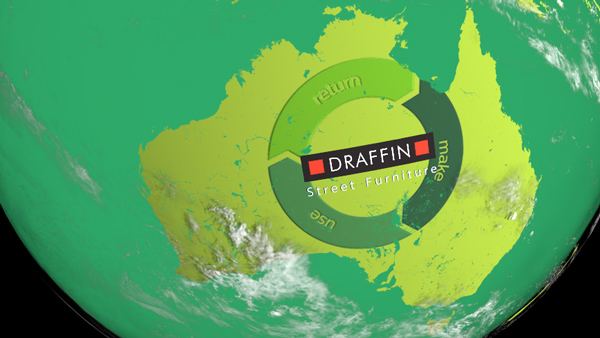
Sustainability of Materials can be defined in 3 ways. There is important criteria to consider to determine whether a material is sustainable:

Sustainability of Materials can be defined in 3 ways. There is important criteria to consider to determine whether a material is sustainable:
The emission footprints of the material, especially those related to carbon, water and air, are minimised. Reuse and recyclability are at high levels. The material has low maintenance costs and a long life, both key indicators that the impact of the material on the planet is at the lowest levels possible.
The industries producing the material show long-term sustainability and growth, provide excellent reliability and quality for their customers, and ensure a solid and reliable supply chain to the end consumer.
The material, in its use or in its production process, respects the human being, especially in terms of health and safety. A sustainable material does not harm the people working to produce it, or the people who handle it during its use, recycling and ultimate disposal.
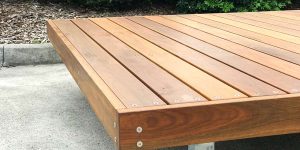 Sustainability of Materials is very important to Draffin Street Furniture. We continuously strive to source sustainable materials for use in our products. Since manufacturers of the materials we source have more vested interest in the economic sustainability of the material, and highest health and safety measures are always observed, this document will focus on the environmental sustainability of materials that are used in our products.
Sustainability of Materials is very important to Draffin Street Furniture. We continuously strive to source sustainable materials for use in our products. Since manufacturers of the materials we source have more vested interest in the economic sustainability of the material, and highest health and safety measures are always observed, this document will focus on the environmental sustainability of materials that are used in our products.
Environmentally sustainable materials are materials used throughout our consumer and industrial economy that can be produced in required volumes without depleting non-renewable resources and without disrupting the established steady-state equilibrium of the environment and key natural resource systems.

Recycling is considered sustainable because it reduces both the need for virgin materials at the start of the life cycle and landfill space at the end. Diverting what ends up in landfill and recycling/reusing/repurposing materials.
It is important to know there are limitations to the quality of some materials once recycled. Some slowly degrade each time they are reprocessed, although there are some usually purer materials that can be recycled without limits. For example: Metals and glass can be melted and reused almost without limit. Whereas most plastics degrade chemically somewhat. Although, some useful recycling is still possible for these materials, and they can be repurposed into another material continuing to divert waste from landfill.
The materials we use in street furniture are environmentally sustainable. Draffin Street Furniture source materials that use an acceptable percentage of recyclable content while observing that a decent quantity of that material can be recycled again. Doing our part to “close the loop” here in Australia for a circular economy.
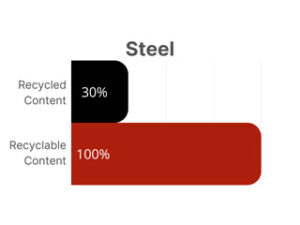
Steel manufacturers claim steel to be one of the world’s most sustainable materials — permanent, forever reusable and the most recycled substance on the planet.
There are two methods to create steel: 73% of steel is produced via a “Basic Oxygen Furnace” (inefficient process), 27% is produced via an “Electric Arc Furnace” (more efficient) Recycling: scrap is either re-processed in an electric arc furnace (90-100% scrap) or used as part of the charge in a Basic Oxygen Furnace (up to 23% scrap).
Due to its purity, any grade of steel can be recycled into new metal, with no ‘downgrading’ from prime to lower quality materials as steel is recycled repeatedly.
Steel’s top sustainability attributes
Source: #steelFacts – worldsteel.org

Stainless steel is 100 percent recyclable. More than half of all the stainless steel materials that are in use today have been sourced from scrap materials. Further impurities are removed and then measured levels of chromium and/or nickel are added depending on the grade.
Its production does not produce toxic run-off, and by design the material has a long service life before recycling again.
Stainless Steel’s top sustainability attributes
Source: Environment | Outokumpu ISSF Website – Recycling (worldstainless.org)
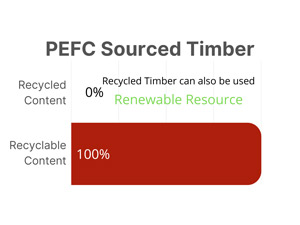
Sustainable timber refers to timber that has been harvested responsibly. i.e. One felled tree is replaced immediately by a new tree with strict environmental standards. PEFC (Program for the Endorsement of Forest Certification) sourced timber is certified as a renewable resource. While growing, this is a material that absorbs carbon from the atmosphere and stores it permanently. We use locally sourced hardwood timber to minimise the carbon footprint and support our local economy.
Our local hardwoods are best suited to the Australian climate, and therefore last longer in outdoor applications.
Timber’s top sustainability attributes
Source: Sustainable Timber | Mathews Timber PEFC (Program for the Endorsement of Forest Certification)
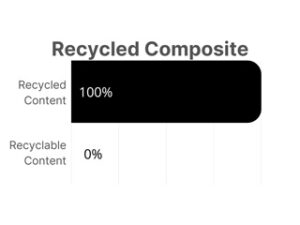
Made from recycled polyolefin materials (plastic from post-industrial waste), rice husks and recycled hardwood wood. These source materials can be classed as 100% recycled. But tight bonding of plastic/organic material into composite material makes it un-recyclable. Very little of this material has reached its “end of life” since its inception due to its long service life, so to date there has been very little advancement in recycling this material, with most opting for “upcycling” the material as the answer.
Recycled Composite’s top sustainability attributes
Source: Futurewood Products

Recycled Plastic sheet is manufactured with material that is mainly sourced from manufacturing waste or “post-industrial recycled polymers”. Industrial plastic waste counts for a considerable amount of the worlds waste plastic. Recycled Plastic sheets are made locally and from local waste streams, from purer materials and can therefore be easily recycled at the end of their service.
Recycled Plastic’s top sustainability attributes
Source: Design Flow – plastic sheets
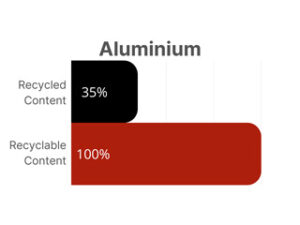
A highly durable metal, aluminium is 100% recyclable and can be recycled again and again without degrading its inherent value. Nearly 75% of all aluminium ever produced is still in use today. Every year, more than 30 million tonnes of aluminium scrap is recycled globally.
Aluminium’s top sustainability attributes
Source: International Aluminium Institute (international-aluminium.org) Sustainability – The International Aluminium Institute
Creating long-life products has always been important to Draffin Street Furniture. This demonstrates the quality of our products and is fundamental to commercial grade outdoor furniture. However, a long-life product also keeps materials in use for longer and requires less maintenance.
Ensuring these materials can be recovered, recycled or repurposed “closes the loop” on precious resources and stops Draffin Street Furniture products being directed to landfill at the end of their service. The sustainability of materials is very important to Draffin Street Furniture, and always considered during design, manufacture and delivery of all products.
Please contact us, should you require further information regarding the sustainability of materials we source and use.
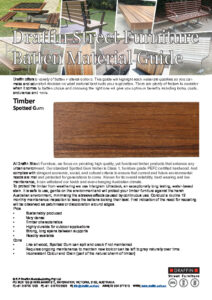 This batten guide lists all standard batten materials we offer for our products. Procured for optimal sustainability characteristics, appearance and durability to ensure maximum performance for a lifetime outdoors.
This batten guide lists all standard batten materials we offer for our products. Procured for optimal sustainability characteristics, appearance and durability to ensure maximum performance for a lifetime outdoors.
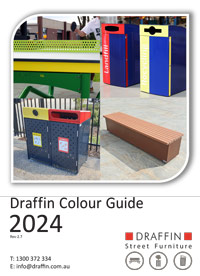 This signage guide lists the full array of standard signage that Draffin offers. Signage communicates with the bin user of the waste type the bin accepts, ensuring a cleaner waste source for recycling.
This signage guide lists the full array of standard signage that Draffin offers. Signage communicates with the bin user of the waste type the bin accepts, ensuring a cleaner waste source for recycling.